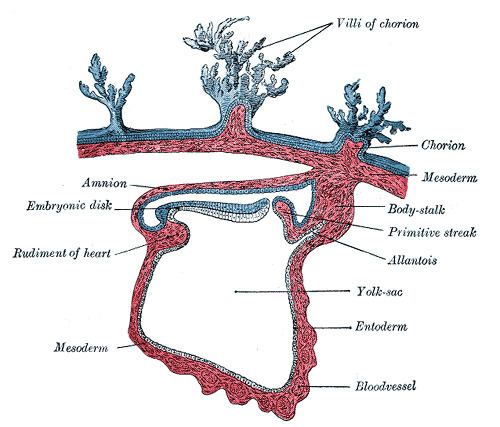Days 8 Gives rise to endoderm Code TE E6.0.1.1.3.0.4 | Precursor inner cell mass Latin hypoblastus | |
 | ||
The hypoblast is a tissue type that forms from the inner cell mass. It lies beneath the epiblast and consists of small cuboidal cells.
Contents
Extraembryonic endoderm (including Yolk sac) is derived from hypoblast cells. The absence of hypoblast results in multiple primitive streaks in chicken embryos. The formation of the primitive streak, through which gastrulation occurs, is induced by Koller's sickle.
In mice
In mouse embryo, the visceral endoderm develop from the primitive endoderm of the blastocyst during the implantation stage covering the epiblast cells and elongates to become an egg cylinder. A distinct morphological domain has been identified by Martin and colleagues, at the distal tip of the mouse egg cylinder, thus this domain was called distal visceral domain (DVE). The DVE cells will move unilaterally to the future anterior until reaching the embryonic/ extra embryonic boundary and at this point, the DVE cells are also named as anterior visceral endoderm (AVE). This migration has been proved to be essential for establishing anteroposterior axis. Besides the AVE, another cell population appears to be separated at the posterior edge of the embryonic egg cylinder, referred to as posterior visceral endoderm (PVE). However, the function of this cell population was not as well studied as AVE.
Function
Although the hypoblast does not contribute to the embryo, it has great influences on the orientation of the embryonic axis. For example, the AVE in hypoblast plays important role in positioning the primitive streak at the midland of the amniote embryos. In chick, people had observed that removal of the hypoblast caused multiple, ectopic primitive streaks formation. Similarly, in mice embryo, the AVE expresses secreted molecules, including two antagonists of Nodal signaling, Cerberus-like (Cerl) and a TGFβ superfamily molecule, Lefty1. It was shown that Cerberus−/−;Lefty1−/− compound mutants mice developed a primitive streak ectopically in the embryo. In addition, there is also finding suggested that the hypoblast also inhibit primitive streak formation by depositing extracellular matrix components to inhibit epithelial-mesenchymal transition (EMT). Besides the role of positioning the site of gastulation, AVE also showed other function including continued protection against caudalization of the early nervous system. Also primitive endoderm derived yolk sac has major function in guaranteeing the proper organogenesis of the fetus and efficient exchange of nutrients, gases and wastes.
History
In mammals, the existence of primitive endoderm had been observed as early as the end of the 19th century as first recognized by Duval and Sobotta. However, it took long time before people realized that the primitive endoderm will be replaced by definitive endoderm which will further develop into the gut tube. The first convincing experiment was conducted by Bellairs in chick embryo with the careful observation under electron and light microscopy. In his experiment, Bellairs demonstrated that there is a transitory endoderm cell layer in the chick embryo at its ventral surface before the formation of primitive streak. This layer of cell was replaced by definitive endoderm migration from the primitive streak through ingression and de-epithelialization. Later on, more insights on primitive endoderm and definitive endoderm origin and formation have been provided in different species including rat and mouse, rhesus monkey, baboon et al.
